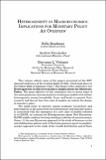Search
Now showing items 1-10 of 38
The international financial system after Covid-19
In March of 2020, international markets seized up with a violence unequaled since the Global Financial Crisis (GFC) nearly a dozen
years before. As economies around the world locked down in the face of the potentially deadly but completely novel SARS-CoV-2 virus, stock markets fell, firms and governments ...
Exchange rate puzzles and policies
What is the optimal exchange rate policy? Should exchange rates be optimally pegged, managed, or allowed to freely float? What defines a freely floating exchange rate? Do open economies face a trilemma constraint in choosing between inflation and exchange rate stabilization, unlike divine coincidence ...
Cross-border corporate control: openness and tax havens
Cross-border corporate control is a major facet of globalisation. In roughly one out of four listed controlled companies in 2012, control was exercised by a foreign entity or family/individual. Controlling—and passive—ownership stakes are often hidden in complex structures, involving pyramids and ...
Heterogeneity in macroeconomics: implications for monetary policy an overview
This volume collects some of the papers presented at the XXV Annual Conference of the Central Bank of Chile, which took place in
November 2022 in Santiago, Chile.1 The theme of the conference was Heterogeneity in Macroeconomics: Implications for Monetary
Policy. The main objective of this conference ...
The reversal problem: development going backwards
The Covid-19 pandemic triggered the most synchronous economic downturn in more than a century. Ninety percent of countries posted a decline in real per-capita GDP in 2020, a share that surpassed any other year since 1900, which includes two world wars and the Great Depression of the 1930s.1 The health ...
International risk spillovers: implications for emerging markets’ monetary policy frameworks with an application to Chile
Among the factors behind international spillovers, U.S. monetary policy developments retain a major influence. Such developments
drive the global financial cycle as strongly demonstrated by Rey (2013), Miranda-Agrippino and Rey (2020), Miranda-Agrippino and
Rey (2021). The dramatic U.S. monetary ...
Global drivers and macroeconomic volatility in EMEs: a dynamic-factor, general-equilibrium perspective
A common view held by academics as well as policymakers assigns an important role to global factors as drivers of fluctuations in economic activity in emerging market economies (EMEs). This follows naturally from the fact that these economies are often small and open to trade in global goods and capital ...
How important is the commodity supercycle?
World commodity prices are known to display long cycles. These cycles have a periodicity of 20 to 30 years and are called commodityprice supercycles. Figure 1 displays the time paths of eleven commodity prices deflated by the U.S. consumer price index over the period 1960 to 2018. All commodity prices ...
Sovereign-Debt Crises and Floating-Rate Bonds
The choice of sovereign-debt maturity in countries at risk of default represents a complex set of competing forces. The tradeoffs reflect the underlying frictions present in international sovereign-debt markets. The primary frictions are the lack of state contingency in debt contracts and the inability ...
Managing an energy shock: fiscal and monetary policy
Prepared for the Proceedings of the XXV Annual Conference of the Central Bank of Chile, held in November 2022. We are grateful for helpful comments and suggestions from Jenny Chan, Sebastián Edwards, Jordi Galí, Peter Ganong, Pierre-Olivier Gourinchas, Jonathan Heathcote, Oleg Itskhoki, Enisse Kharroubi, ...


